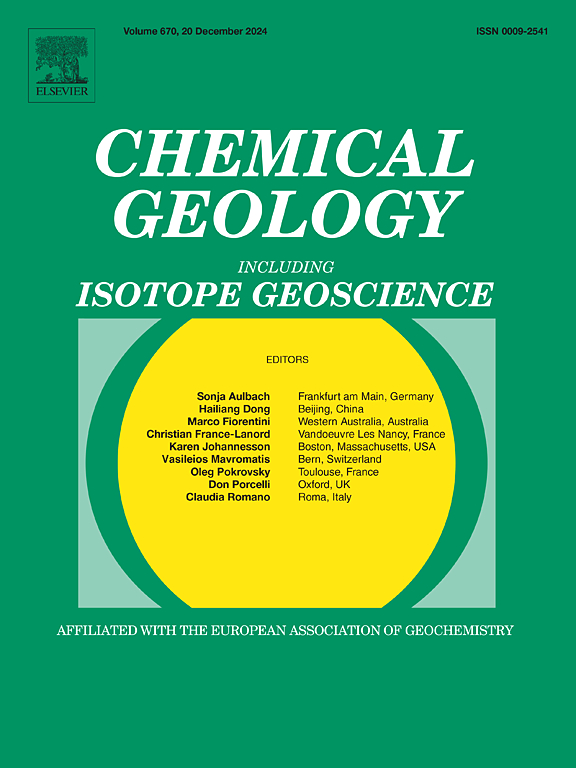Deep regolith weathering controls δ30Si composition of groundwater under contrasting landuse in tropical watersheds
IF 3.6
2区 地球科学
Q1 GEOCHEMISTRY & GEOPHYSICS
引用次数: 0
Abstract
Land use changes are known to alter terrestrial silicon cycling and the export of dissolved silicon from soil to fluvial systems, but the impact of such changes on groundwater systems remain unclear. In order to identify the processes responsible for groundwater geochemistry and to assess the impact of agricultural processes, we examined multiple isotopic tracers (δ30Si, oxygen (δ18O) and hydrogen (δ2H) isotopes) in groundwater, soil porewater and surface water from two contrasted watersheds having the same gneissic lithology, one forested (Mule Hole) and one intensely cultivated (Berambadi) in the Kabini basin in South India. In the cultivated watershed, groundwater exhibits high Cl− and NO3− concentrations indicative of fertilizer inputs and solute enrichment from evapotranspiration due to multiple groundwater pumping/recharge cycles. The DSi concentration in groundwater is significantly higher in the cultivated watershed (980 ± 313 μM) than in the forested one (711 ± 154 μM), indicating more intense evapotranspiration due to irrigation cycles. The groundwater δ30Si values ranged from 0.6 ‰ to 3.4 ‰ and exhibit no significant differences between cultivated (1.2 ± 0.5 ‰) and forested (1.0 ± 0.2 ‰) watersheds, indicating limited impact of land use and land cover. Groundwater also shows no significant seasonal differences in DSi and δ30Si within watersheds, indicating a buffer to seasonal recharge during wet season. The δ30Si of a majority of groundwater samples fits a steady-state open flow through system, with an isotopic fractionation factor (30ε) between precipitating phase and groundwater ranging from −1.0 ‰ and − 2.0 ‰, consistent with precipitation of kaolinite-type clays, dominant in the study area. The steady-state flow through system in groundwater can be interpreted as a continuous DSi input from mineral weathering reactions with a dynamic equilibrium between Si supply and precipitation of secondary phases. We also observe, in both watersheds, similar DSi and δ30Si values in local surface water that includes small streams and a river (406 ± 194 μM, 1.6 ± 0.3 ‰) and in soil porewater (514 ± 119 μM, 1.6 ± 0.2 ‰). Compared to soil porewater, groundwater exhibits significantly lower δ30Si signatures and higher DSi, reflecting the contribution of an isotopically light silicon source, resulting from water-rock interaction during percolation through the unsaturated zone. We assign this steady input of DSi to the weathering of primary silicate minerals in the regolith, such as Na-plagioclase, biotite and chlorite, with formation of kaolinite and smectites type clays. A simple isotopic mass balance suggests that deep regolith weathering can contribute to almost half of the DSi in groundwater. We conclude that silicon cycling in soil porewaters, and surface waters are directly impacted by land use, while the isotopic composition of groundwater remains unaffected. Our results indicate that Si isotopic signatures of weathering, adsorption, and plant uptake occurring in the shallow soil and saprolite horizons are partly overprinted and homogenized by the regolith weathering in the deep critical zone, irrespective of land use and seasonality.
深层沉积物风化控制热带流域土地利用对比下的地下水δ30Si成分
众所周知,土地利用的变化会改变陆地硅循环以及溶解硅从土壤向河流系统的输出,但这种变化对地下水系统的影响仍不清楚。为了确定造成地下水地球化学的过程并评估农业过程的影响,我们研究了南印度卡比尼盆地两个具有相同片麻岩岩性的对比流域的地下水、土壤孔隙水和地表水中的多种同位素示踪剂(δ30Si、氧(δ18O)和氢(δ2H)同位素)。在耕地流域,地下水中的 Cl- 和 NO3- 浓度较高,表明由于多次抽取/回灌地下水,肥料输入和蒸腾作用导致溶质富集。耕地流域地下水中的 DSi 浓度(980 ± 313 μM)明显高于森林流域(711 ± 154 μM),这表明灌溉周期造成的蒸散作用更为强烈。地下水 δ30Si 值介于 0.6 ‰ 至 3.4 ‰ 之间,耕地流域(1.2 ± 0.5 ‰)与森林流域(1.0 ± 0.2 ‰)之间无明显差异,表明土地利用和土地覆盖的影响有限。流域内地下水的 DSi 和 δ30Si 也没有明显的季节性差异,表明雨季对季节性补给有缓冲作用。大部分地下水样本的 δ30Si 符合稳态开放式流经系统,沉淀相与地下水之间的同位素分馏系数(30ε)在-1.0 ‰和-2.0 ‰之间,与研究区域内主要的高岭石型粘土沉淀一致。地下水中的稳态流经系统可解释为矿物风化反应持续输入 DSi,Si 供应与次生相沉淀之间达到动态平衡。我们还观察到,在这两个流域中,当地地表水(包括小溪和河流)(406 ± 194 μM,1.6 ± 0.3 ‰)和土壤孔隙水(514 ± 119 μM,1.6 ± 0.2 ‰)中的 DSi 和 δ30Si 值相似。与土壤孔隙水相比,地下水的δ30Si特征明显较低,而DSi较高,这反映了在非饱和带渗流过程中水与岩石相互作用产生的同位素轻硅源的贡献。我们将这种稳定的DSi输入归因于风化沉积岩中的原生硅酸盐矿物,如钠斜长石、斜长石和绿泥石,并形成高岭石和软玉型粘土。简单的同位素质量平衡表明,地下水中近一半的 DSi 是由深层摄岩石风化造成的。我们的结论是,土壤孔隙水和地表水中的硅循环直接受到土地利用的影响,而地下水的同位素组成则不受影响。我们的研究结果表明,无论土地利用和季节性如何,浅层土壤和边坡岩层中发生的风化、吸附和植物吸收的硅同位素特征都会部分地被深层临界区的岩石风化所覆盖和均匀化。
本文章由计算机程序翻译,如有差异,请以英文原文为准。
求助全文
约1分钟内获得全文
求助全文
来源期刊

Chemical Geology
地学-地球化学与地球物理
CiteScore
7.20
自引率
10.30%
发文量
374
审稿时长
3.6 months
期刊介绍:
Chemical Geology is an international journal that publishes original research papers on isotopic and elemental geochemistry, geochronology and cosmochemistry.
The Journal focuses on chemical processes in igneous, metamorphic, and sedimentary petrology, low- and high-temperature aqueous solutions, biogeochemistry, the environment and cosmochemistry.
Papers that are field, experimentally, or computationally based are appropriate if they are of broad international interest. The Journal generally does not publish papers that are primarily of regional or local interest, or which are primarily focused on remediation and applied geochemistry.
The Journal also welcomes innovative papers dealing with significant analytical advances that are of wide interest in the community and extend significantly beyond the scope of what would be included in the methods section of a standard research paper.
 求助内容:
求助内容: 应助结果提醒方式:
应助结果提醒方式:


